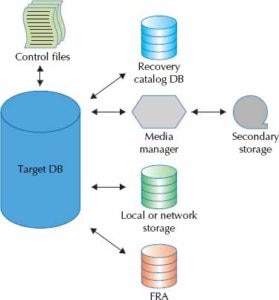Recovery Manager (RMAN) is the tool for backup and recovery of Oracle databases. RMAN is client software that connects to a target database and performs backups or recovery on it. RMAN always stores data about itself and its operations in the database control files as well as a special schema in another database. The best practice is to use the schema for storing the metadata of RMAN, which is called a recovery catalog.
RMAN is a command line–based tool and a GUI option embedded in Oracle Enterprise Manager as well as grid/cloud control. It is the most efficient way to back up and recover any Oracle database. It is tightly integrated with the server, providing features such as block-level corruption detection during backup and restore activities. It has self-optimizing features, including multiplexing of backup channels and sophisticated compression of backupset pieces.
RMAN Metadata
By default, the RMAN metadata is stored in the database control files. RMAN also offers a recovery catalog feature, which is simply another database used in addition to the control files to store metadata backup. Many DBAs prefer using the catalog approach as it offers an opportunity to store metadata about a handful of Oracle databases and leads to easy consolidation of backup information. The catalog is optional and many adopters prefer using this approach for redundancy and manageability. Figure 1illustrates the main components of an RMAN implementation, including
- The target database The repository being backed up.
- The control files A standard component of any Oracle database implementation.
- The catalog database The optional secondary database storage location for RMAN metadata.
- Media manager Provides an interface to third-party storage technology whose usage is not directly bundled with the RMAN technology.
- Flash Recovery Area (FRA) One can store RMAN backupset pieces once this Oracle-managed area is defined in the system parameter file.
- Traditional storage Disk backup location(s) where RMAN backupset pieces are written.
See Reasons to Use RMAN
RMAN makes it very easy to implement the simple and advanced backup strategies. With RMAN, you can automate the backup tasks. RMAN can delete unneeded and obsolete backup files automatically. RMAN can compress the backups allowing you to save storage. RMAN provides you with comprehensive reporting regarding your backups. If you are using the Automatic Storage Management (ASM) feature, then RMAN is the best tool to handle the files. You can test your backups with RMAN. You can even check whether your backups are recoverable without actually recovering the backups. RMAN also checks for any block corruption while backing up, and the list of benefits goes on. In addition to what has already been discussed, RMAN is the obvious choice for backing up the 12c database for the following reasons:
- Automated management of backups once instructions have been registered with the RMAN engine as to how they should be retained, declared obsolete, and aged out of the repository
- Ability to store and run user-defined scripts in the recovery catalog database
- Comprehensive reporting capabilities
- Enterprise-wide management of and consistent implementation of corporate-wide standards through cloud control and Enterprise Manager

Leave a Reply